Xiaowei Yuan
Reinforced Internal-External Knowledge Synergistic Reasoning for Efficient Adaptive Search Agent
May 12, 2025Abstract:Retrieval-augmented generation (RAG) is a common strategy to reduce hallucinations in Large Language Models (LLMs). While reinforcement learning (RL) can enable LLMs to act as search agents by activating retrieval capabilities, existing ones often underutilize their internal knowledge. This can lead to redundant retrievals, potential harmful knowledge conflicts, and increased inference latency. To address these limitations, an efficient and adaptive search agent capable of discerning optimal retrieval timing and synergistically integrating parametric (internal) and retrieved (external) knowledge is in urgent need. This paper introduces the Reinforced Internal-External Knowledge Synergistic Reasoning Agent (IKEA), which could indentify its own knowledge boundary and prioritize the utilization of internal knowledge, resorting to external search only when internal knowledge is deemed insufficient. This is achieved using a novel knowledge-boundary aware reward function and a knowledge-boundary aware training dataset. These are designed for internal-external knowledge synergy oriented RL, incentivizing the model to deliver accurate answers, minimize unnecessary retrievals, and encourage appropriate external searches when its own knowledge is lacking. Evaluations across multiple knowledge reasoning tasks demonstrate that IKEA significantly outperforms baseline methods, reduces retrieval frequency significantly, and exhibits robust generalization capabilities.
Exploiting Contextual Knowledge in LLMs through V-usable Information based Layer Enhancement
Apr 22, 2025Abstract:Large Language Models (LLMs) have demonstrated remarkable capabilities in various tasks, yet they often struggle with context-faithfulness generations that properly reflect contextual knowledge. While existing approaches focus on enhancing the decoding strategies, they ignore the fundamental mechanism of how contextual information is processed within LLMs' internal states. As a result, LLMs remain limited in their ability to fully leverage contextual knowledge. In this paper, we propose Context-aware Layer Enhancement (CaLE), a novel intervention method that enhances the utilization of contextual knowledge within LLMs' internal representations. By employing V-usable information analysis, CaLE strategically amplifies the growth of contextual information at an optimal layer, thereby enriching representations in the final layer. Our experiments demonstrate that CaLE effectively improves context-faithful generation in Question-Answering tasks, particularly in scenarios involving unknown or conflicting contextual knowledge.
Improving Zero-shot LLM Re-Ranker with Risk Minimization
Jun 19, 2024



Abstract:In the Retrieval-Augmented Generation (RAG) system, advanced Large Language Models (LLMs) have emerged as effective Query Likelihood Models (QLMs) in an unsupervised way, which re-rank documents based on the probability of generating the query given the content of a document. However, directly prompting LLMs to approximate QLMs inherently is biased, where the estimated distribution might diverge from the actual document-specific distribution. In this study, we introduce a novel framework, $\mathrm{UR^3}$, which leverages Bayesian decision theory to both quantify and mitigate this estimation bias. Specifically, $\mathrm{UR^3}$ reformulates the problem as maximizing the probability of document generation, thereby harmonizing the optimization of query and document generation probabilities under a unified risk minimization objective. Our empirical results indicate that $\mathrm{UR^3}$ significantly enhances re-ranking, particularly in improving the Top-1 accuracy. It benefits the QA tasks by achieving higher accuracy with fewer input documents.
Discerning and Resolving Knowledge Conflicts through Adaptive Decoding with Contextual Information-Entropy Constraint
Feb 19, 2024Abstract:Large language models internalize enormous parametric knowledge during pre-training. Concurrently, realistic applications necessitate external contextual knowledge to aid models on the underlying tasks. This raises a crucial dilemma known as knowledge conflicts, where the contextual knowledge clashes with the However, existing decoding works are specialized in resolving knowledge conflicts and could inadvertently deteriorate performance in absence of conflicts. In this paper, we propose an adaptive decoding method, termed as contextual information-entropy constraint decoding (COIECD), to discern whether the knowledge conflicts occur and resolve them. It can improve the model's faithfulness to conflicting context, and simultaneously maintain high performance among non- Our experiments show that COIECD exhibits strong performance and robustness over knowledge conflicts in realistic datasets. Code is available.
Learning Representation for Anomaly Detection of Vehicle Trajectories
Mar 09, 2023Abstract:Predicting the future trajectories of surrounding vehicles based on their history trajectories is a critical task in autonomous driving. However, when small crafted perturbations are introduced to those history trajectories, the resulting anomalous (or adversarial) trajectories can significantly mislead the future trajectory prediction module of the ego vehicle, which may result in unsafe planning and even fatal accidents. Therefore, it is of great importance to detect such anomalous trajectories of the surrounding vehicles for system safety, but few works have addressed this issue. In this work, we propose two novel methods for learning effective and efficient representations for online anomaly detection of vehicle trajectories. Different from general time-series anomaly detection, anomalous vehicle trajectory detection deals with much richer contexts on the road and fewer observable patterns on the anomalous trajectories themselves. To address these challenges, our methods exploit contrastive learning techniques and trajectory semantics to capture the patterns underlying the driving scenarios for effective anomaly detection under supervised and unsupervised settings, respectively. We conduct extensive experiments to demonstrate that our supervised method based on contrastive learning and unsupervised method based on reconstruction with semantic latent space can significantly improve the performance of anomalous trajectory detection in their corresponding settings over various baseline methods. We also demonstrate our methods' generalization ability to detect unseen patterns of anomalies.
Emoji-aware Co-attention Network with EmoGraph2vec Model for Sentiment Anaylsis
Oct 27, 2021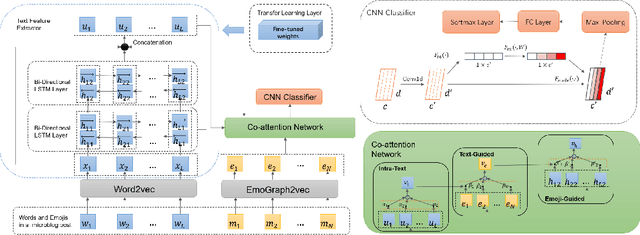
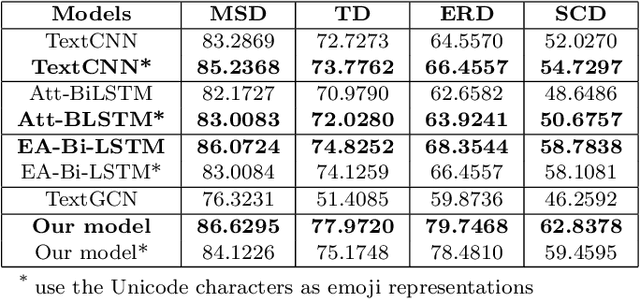


Abstract:In social media platforms, emojis have an extremely high occurrence in computer-mediated communications. Many emojis are used to strengthen the emotional expressions and the emojis that co-occurs in a sentence also have a strong sentiment connection. However, when it comes to emoji representation learning, most studies have only utilized the fixed descriptions provided by the Unicode Consortium, without consideration of actual usage scenario. As for the sentiment analysis task, many researchers ignore the emotional impact of the interaction between text and emojis. It results that the emotional semantics of emojis cannot be fully explored. In this work, we propose a method to learn emoji representations called EmoGraph2vec and design an emoji-aware co-attention network that learns the mutual emotional semantics between text and emojis on short texts of social media. In EmoGraph2vec, we form an emoji co-occurrence network on real social data and enrich the semantic information based on an external knowledge base EmojiNet to obtain emoji node embeddings. Our model designs a co-attention mechanism to incorporate the text and emojis, and integrates a squeeze-and-excitation (SE) block into a convolutional neural network as a classifier. Finally, we use the transfer learning method to increase converge speed and achieve higher accuracy. Experimental results show that the proposed model can outperform several baselines for sentiment analysis on benchmark datasets. Additionally, we conduct a series of ablation and comparison experiments to investigate the effectiveness of our model.
Emoji-based Co-attention Network for Microblog Sentiment Analysis
Oct 27, 2021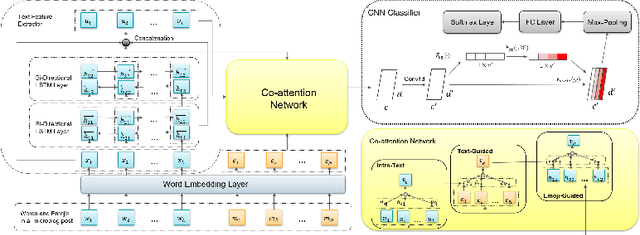
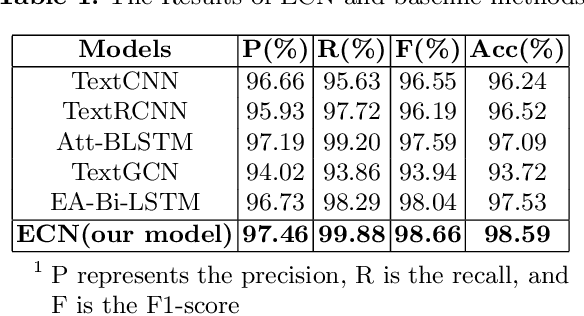
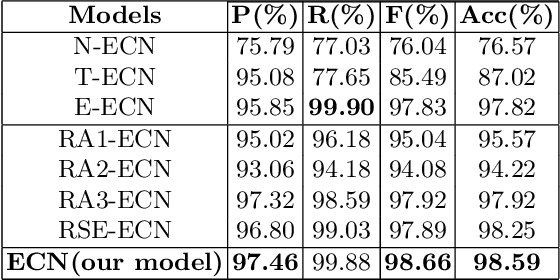
Abstract:Emojis are widely used in online social networks to express emotions, attitudes, and opinions. As emotional-oriented characters, emojis can be modeled as important features of emotions towards the recipient or subject for sentiment analysis. However, existing methods mainly take emojis as heuristic information that fails to resolve the problem of ambiguity noise. Recent researches have utilized emojis as an independent input to classify text sentiment but they ignore the emotional impact of the interaction between text and emojis. It results that the emotional semantics of emojis cannot be fully explored. In this paper, we propose an emoji-based co-attention network that learns the mutual emotional semantics between text and emojis on microblogs. Our model adopts the co-attention mechanism based on bidirectional long short-term memory incorporating the text and emojis, and integrates a squeeze-and-excitation block in a convolutional neural network classifier to increase its sensitivity to emotional semantic features. Experimental results show that the proposed method can significantly outperform several baselines for sentiment analysis on short texts of social media.
Face De-occlusion using 3D Morphable Model and Generative Adversarial Network
Apr 12, 2019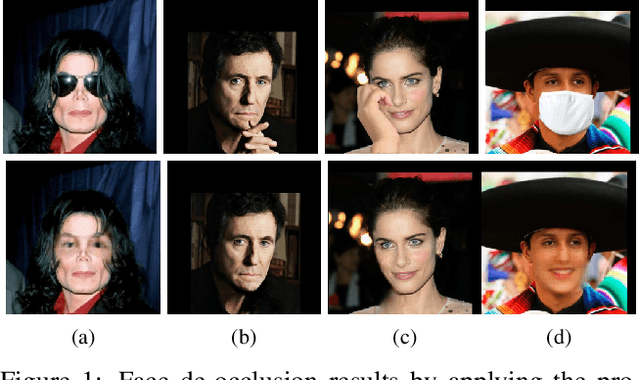
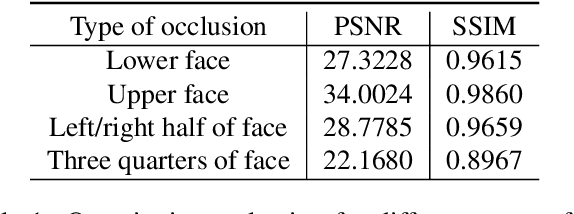

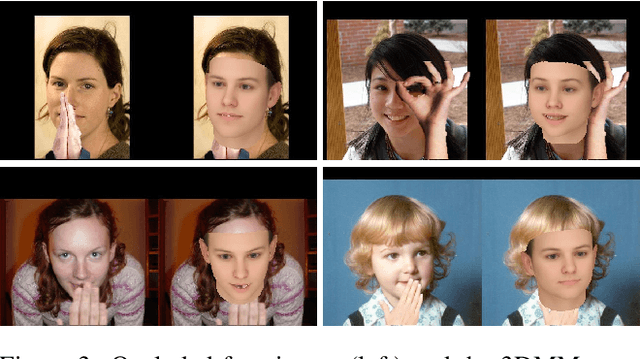
Abstract:In recent decades, 3D morphable model (3DMM) has been commonly used in image-based photorealistic 3D face reconstruction. However, face images are often corrupted by serious occlusion by non-face objects including eyeglasses, masks, and hands. Such objects block the correct capture of landmarks and shading information. Therefore, the reconstructed 3D face model is hardly reusable. In this paper, a novel method is proposed to restore de-occluded face images based on inverse use of 3DMM and generative adversarial network. We utilize the 3DMM prior to the proposed adversarial network and combine a global and local adversarial convolutional neural network to learn face de-occlusion model. The 3DMM serves not only as geometric prior but also proposes the face region for the local discriminator. Experiment results confirm the effectiveness and robustness of the proposed algorithm in removing challenging types of occlusions with various head poses and illumination. Furthermore, the proposed method reconstructs the correct 3D face model with de-occluded textures.
 Add to Chrome
Add to Chrome Add to Firefox
Add to Firefox Add to Edge
Add to Edge